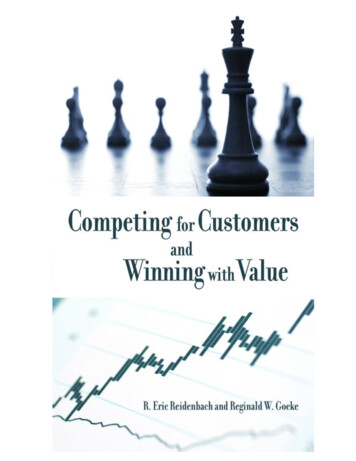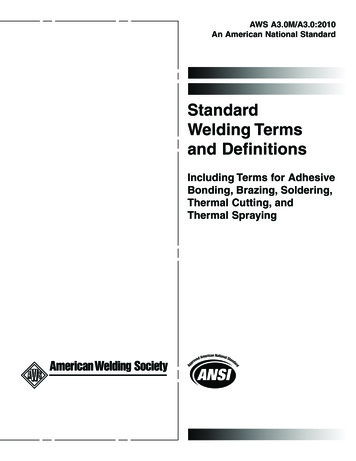
Transcription
1
American Society for Quality, Quality Press, Milwaukee 53203 2006 by ASQ Quality PressAll rights reserved. Published 2006Printed in the United States of America12 11 10 09 08 07 06 5 4 3 2 1Library of Congress Cataloging-in-Publication DataReidenbach, R. Eric.Competing for customers and winning with value : breakthrough strategies formarket dominance / R. Eric Reidenbach and Reginald W. Goeke.-- 1st ed.p. cm.Includes bibliographical references.ISBN 0-87389-680-71. Business planning. I. Goeke, Reginald W. II. Title.HD30.28.R4193 2006658.4'012--dc222005035019ISBN-13: 978-0-87389-680-1ISBN-10: 0-87389-680-7No part of this book may be reproduced in any form or by any means, electronic, mechanical, photocopying, recording, orotherwise, without the prior written permission of the publisher.Publisher: William A. TonyAcquisitions Editor: Annemieke HytinenProject Editor: Paul O'MaraProduction Administrator: Randall BensonASQ Mission: The American Society for Quality advances individual, organizational, and community excellenceworldwide through learning, quality improvement, and knowledge exchange.Attention Bookstores, Wholesalers, Schools, and Corporations: ASQ Quality Press books, videotapes, audiotapes, andsoftware are available at quantity discounts with bulk purchases for business, educational, or instructional use. Forinformation, please contact ASQ Quality Press at 800-248-1946, or write to ASQ Quality Press, P.O. Box 3005,Milwaukee, WI 53201-3005.To place orders or to request a free copy of the ASQ Quality Press Publications Catalog, including ASQ membershipinformation, call 800-248-1946. Visit our Web site at www.asq.org or http://qualitypress.asq.org.Printed on acid-free paperQuality Press600 N. Plankinton AvenueMilwaukee, Wisconsin 53203Call toll free 800-248-1946Fax http://standardsgroup.asq.orgE-mail: authors@asq.org2
Table of ContentsTable of Contents . 3List of Tables and Figures. 6Preface. 8Introduction . 10Part I: The Competitive Foundation . 15Chapter 1: Planning for Competition . 16Corporate Level Planning . 18Strategic Business Unit Planning . 20Product/Market Level Planning . 21Chapter 2: The Value Advantage . 26What is Customer Value? . 26Value Properties . 28Value is Relative . 28Value is Product and Market Specific . 28Value is Learned . 29Why Value and Not Satisfaction? . 30Linkage to Performance . 30What Factors Make Value a Better Strategic Measure? . 33Customer Value is Market Based . 33Customer Value Equals Worth . 33Customer Value is a Cognitive Measure . 34Chapter 3: Growing Market Share with Value: Customer Acquisition . 35The Value Model: . 35The Information Platform . 35The Competitive Value Matrix: . 38The Strategic Radar Screen . 38Driver-Level Analysis . 40Attribute-Level Analysis . 41The Vulnerability Matrix: . 42A Powerful Acquisition Tool . 42Chapter 4: Growing Market Share with Value: Customer Retention . 46The Value of Customer Loyalty . 47Assessing Customer Loyalty. 50Using the Customer Loyalty Matrix for Interventions . 52Part II: The Competitive Planning Process . 57Chapter 5: Choosing Where to Compete . 58Focus, Focus, Focus . 59Product Lines . 60Market Segments . 61Identifying Where to Compete. 62Chapter 6: What is the Organization’s Current Value Proposition? . 74What is your current value proposition? . 74A Value Driver Summary . 74Competitive Value Analysis . 763
Value Strengths and Weaknesses. 78Driver-Level Analysis . 78VPC-Level Analysis . 79Identification of Market Opportunities . 80Customer Acquisition . 84Customer Retention . 87Chapter 7: What Does the Organization Want its Competitive Value Proposition to Be?91Product/Market Objectives . 91Assumptions. 92Develop a Product/Market Strategy . 93Product/Market Strategy . 105Chapter 8: How Does the Organization Manage its Value Proposition?. 107Marketing Mix Objectives . 107Product/Market Strategy . 107Product/Market Action Programs . 110Cost . 113Budgets and Forecasts. 114Chapter 9: The Value-Strategy-Process Linkage . 116Calculate Critical Value Gaps . 118Identify the Key Value Stream . 119Constructing the CTQ/Process Matrix . 122Target Processes for Six Sigma or Lean Projects . 123Establish Priorities for Lean or Six Sigma Projects . 125Chapter 10: Monitoring Plan Effectiveness . 128Internal Performance Metrics . 130Transactional Measures of Customer Value . 131Data Collection . 132Responsiveness . 133Real-Time Reporting . 134“Dashboard” Overview . 136Diagnostic Snapshots . 137Alignment of Business Information Systems . 139Part III: Competitive Planning Deployment . 141Chapter 11: Fourteen Keys to Successful Deployment . 142Short-term Keys to Successful Deployment . 1431. Corporate Champion . 1432. Don’t Measure Unless You Plan to Manage. 1443. Strategic Focus . 1454. Rely on Customers for the Right Questions . 1465. Reliable Research Vendors . 1476. Understand Needs of Internal Customers . 1487. Effective Utilization of Multi-Functional Teams . 1508. Reward Employees for Their Contributions . 151Keys to Success for the Long Haul . 1529. Move the Organization Beyond a Technological View of Value . 15210. Integrate the Discipline of Other Initiatives. 1534
11. Plan Performance Reviews . 15512. Evaluate Alignment of Corporate, Business Unit, and Product/Market Strategies. 15513. Structure Follows Strategy. 15614. Manage Culture Change . 158Chapter 12: Competing for Customers . 160What is the Organization’s Current Value Proposition?. 161What is the Organization’s Intended Value Proposition? . 162How Does the Organization Achieve its Intended Value Proposition? . 162Has the Organization Achieved its Objectives?. 163Appendix A: . 164Technical Notes on Value Measurement . 164Attributes/Value Performance Criteria . 164Importance Scores:. 164Stated versus Derived . 164Multicollinearity . 165R Squares . 165Model Characteristics . 166Identifying Relationships . 166Multiple Measures . 166Market-Based Models . 167APPENDIX B . 168Environmental Trend Analysis . 168APPENDIX C . 173COMPETITIVE MARKET PLANNING FORMS . 173Product/Market Matrix. 175Environmental Scanning . 176Qualifying Needs of Segment . 177Determining Needs of Segment . 178Market Share and Trends . 179Value Proposition Assessment . 180Differential Value Advantage/Disadvantage . 181Market Opportunity Identification . 182Strategy and Objectives . 184Product/Market Action Programs . 186Budget and Market Forecast . 187GLOSSARY . 188References . 1915
List of Tables and FiguresFigure 1.1Figure 1.2The Context of Competitive PlanningGrowth StrategiesFigure 2.1Figure 2.2A Comprehensive View of ValueCustomer value Drives ProfitabilityFigure 3.1Competitive Value Model: Printing Equipment/Large ContainerManufacturersCompetitive Value Matrix: Printing Equipment/Large ContainerManufacturersDriver Level AnalysisVPC Level AnalysisCompetitive Vulnerability Matrix – Competitor 1Driver Analysis – Competitor 1Figure 3.2Table 3.1Table 3.2Figure 3.3Table 3.3Figure 4.1Figure 4.2Table 4.1Table 4.2Table 4.3Figure 4.3Customer Value Matrix: Printing Equipment/Large ContainerManufacturersThe Customer Loyalty MatrixRecommendation and Switching Intentions by Value GroupQuality and Driver Scores by Value GroupSales Process VPC Ratings for Value Group 4Value Groups by Distributor TerritoriesFigure 5.1Figure 5.2Figure 5.3Figure 5.4Table 5.1Table 5.2Figure 5.5Figure 5.6Figure 5.7Figure 5.8Planning Levels and PurposesProduct/Market MatrixP/M Matrix: Plastics Equipment ManufacturerP/M Matrix: Heavy Equipment DealershipMarket AttractivenessAbility to CompeteMarket Segment Investing MatrixHeavy Equipment Dealer’s PrioritiesP/M Matrix: Financial ServicesAligning National and Local Competitive OpportunitiesFigure 6.1Figure 6.2Table 6.1Table 6.2Table 6.3Figure 6.3Figure 6.4Table 6.4Table 6.5Competitive Value Model: Disability Insurance/Large BusinessesCompetitive Value Matrix: Disability Insurance/Large BusinessesHead-to-Head Driver AnalysisDriver VPC for Disability InsuranceStrengths and Weaknesses at VPC LevelValue Opportunity Identification MatrixCompetitive Value Matrix: Disability Insurance/Large BusinessesCompetitor VulnerabilitiesQuality Driver Performance Ratings – Competitor 36
Table 6.6Figure 6.5Table 6.7Quality Driver Performance Ratings – Competitor 5Customer Loyalty Matrix: XYZ CorporationXYZ Performance Ratings by Value GroupFigure 7.1Figure 7.2Figure 7.3Figure 7.4Figure 7.5Table 7.1Figure 7.6Table 7.2Figure 7.7Figure 7.8Figure 7.9Table 7.3Fork Lifts/Warehouse Value Model (Internal Perspective)Fork Lifts/Warehouse Value Model (Market Perspective)Fork Lifts/Warehouse Value Proposition (Internal Perspective)Fork Lifts/Warehouse Value Proposition (Market Perspective)Competitive Value Matrix: ISP/Residential UsersHead-to-Head Driver Analysis: Fork Lifts/WarehouseValue Opportunity Identification MatrixHead-to-Head VPC AnalysisSimulation at T1Simulation at T4Customer Loyalty matrixValue Group Driver RatingsFigure 8.1Table 8.1Table 8.2Figure 8.2Marketing Mix ObjectivesProduct/Market Action Programs – ServiceProduct/Market Action Programs – SalesBudget and Market ForecastFigure 9.1Table 9.1Figure 9.2Table 9.2Table 9.3Figure 9.3Table 9.4The Value-Strategy-Process LinkageCalculation of CTQ GapsCustomer-Focused Value StreamValue Performance Criteria GapCTQ/Process MatrixThe Service/Repair Value Stream MapProcess Improvement OpportunitiesFigure 10.1Figure 10.2Figure 10.3Figure 10.4Figure 10.5Figure 10.6Figure 10.7Figure 10.8Figure 10.9Figure 10.10Objectives Require Monitoring MetricsAction Programs and Performance MeasuresRepair Promise/Delivery TimesTransactional SurveySurvey Linkage to CRMMenu-Driven Reporting SystemPerformance Trend ReportManagement DashboardElectricity/Residential Users Value Model“Routine Transactions” AttributesFigure 11.1Figure 11.2Customer Value Linkage to Six SigmaA Structure in Support of a StrategyFigure 12.1The Context of Competitive Planning7
PrefaceCompeting for Customers and Winning with Value brings together, for the first time, twovery powerful concepts: customer value and competitive planning. Together they createa powerful tool that will generate breakthrough strategies for market dominance.Value is not a new concept. On the contrary, the concept of value has been around for along time, but the ability to operationalize that concept into a meaningful tool forbusiness managers has come about much more recently. The previously fashionablemetrics of customer satisfaction have proven to be poor predictors of businessperformance, whereas the linkages between customer value and performance measuressuch as market share and profitability have been identified and documented. In fact,value has been shown to be one of the best predictors of market share and customerloyalty available. It is only natural, then, that developing a system to harness value as acompetitive weapon is an essential next step. This is the objective of Competing forCustomers.The second concept that Competing with Customers brings to the table is a competitiveplanning template that enables organizations to actually harness their value creation anddelivery systems to enhance their market performance. It is a planning system thatfocuses at the level where the organization makes money: selling products or services topeople in specific markets or market segments.Every business organization has plans for growth – whether these are formal or informal,well-documented or intuitive. This type of planning is typically done at the highest levelsof the organization, and usually does not and can not address the questions of where andhow the organization should compete in order to win and retain customers. And whencompetitive planning at the more granular level does take place, there is frequently adisconnect between these planning levels, with the result that the organization plowsrudderless through the competitive waters unable to navigate the demanding dynamics ofthe market place. Competing for Customers provides the framework for bringing themultiple levels of planning into alignment, and to address very specifically the question,“How do we compete?”Organizations have the power to choose where they compete and how they compete. Thecompetitive arena is a product/market – a market or market segment that buys specificproducts or services. This is where competitive planning takes place. It focuses onanswering a series of very specific questions answered by the metrics of customer value.It accommodates the shifting complexities of a constantly changing market place bycreating the necessary focus to understand how competitors compete.Within each product/market in which the organization chooses to compete, the firstquestion is “What is the organization’s competitive value proposition?” How do buyerswithin the product/market define the value they seek, and how do they perceive the value8
our organization provides relative to that of the competition? Failing to answer these twoquestions or, worse, not asking them in the first place, puts the organization at a severecompetitive disadvantage.Once the organization understands its competitive value proposition it has to ask “Is thisthe value proposition that we want?” If the organization’s value proposition isundifferentiated from its competitors, it is offering buyers no compelling reason to buy itsproducts. This shows up in stagnating share positions and mediocre profits. If its actualvalue proposition is inferior to its competitors, then it can expect declining sharepositions and lower profits.Understanding the value gaps between an organization and its competitors, along with thepotential value-enhancing opportunities those present, raises the question “How does theorganization manage its competitive value proposition in order to either close the valuegap with leading competitors or widen it in order to establish undisputed leadership?”Competing for Customers provides a blueprint for effectively managing theorganization’s value proposition by specifying clear objectives supported by a clear andfocused strategy.Finally, the organization has to monitor its competitive value proposition. Theorganization’s value proposition is an important asset providing a compelling reason todo business with the organization. It requires continuous management. Just as anorganization manages its inventories, distribution system, or pricing strategies, so too,must it manage its value proposition. Failure to do so means that the organization isleaving this critically important asset to the whims of its competitors.Competing for Customers and Winning with Value provides the reader with a clearblueprint for crafting breakthrough, value-added strategies to dominate thoseproduct/markets that the organization targets. For many readers it will challenge the waythey look at their competition, their markets and their industries. Competition will neverlook the same.9
IntroductionElementary economics would tell you that every business firm seeks to identify andoccupy a position that is somehow unique from that of its competitors. This is the veryessence of competition. Uniqueness creates a compelling selling proposition and anopportunity to increase the firm’s share of the market as long as the uniqueness issomething that is valued by the market. In the past and, to a large extent even today, thisuniqueness has been based on product differences such as those created and enjoyed byMicrosoft. Distribution differences, such as those that have powered the Caterpillarengine are another form of differentiation. Image differences have been a powerful toolemployed by companies such as Mercedes or Lexus. Price differences are yet anothertype of differentiation perhaps no better employed than by Walmart, Costco, or Yugo.Outstanding firms are constantly seeking newer and better ways to differentiatethemselves from their competitors.All firms compete. Some are better at it than are others. Less innovative firms, lackingthe ability and capacity to effectively differentiate can only challenge the leaders at best,or follow. Some industries, to their current detriment, have managed themselves into acommodity situation where differentiation is no longer possible.The retail banking industry had, in response to the dying S&L industry, bet the mortgageon a price competition where the belief was that the only way banks can woo customersfrom the S&Ls was to cut their fees and prices. In the face of the dubious S&L strategyof losing a dollar on every transaction and making it up in volume, bank managementspanicked and began cutting prices. In fact, this price cutting evolved into strategies ofgiving product and service away for free. The current result is that many banks haveturned themselves into kernels of corn or hog bellies in the eyes of their markets. Thereis little if any differentiation among banks. They are in fact commodities offeringcommodity products and services. To quote Gertrude Stein, “A bank is a bank is abank”. Unfortunately, as any marketer worth his or her salt will tell you, there need be nosuch a thing as a commodity. Just ask Orville Redenbacher or Sam Purdue.Banks are not alone. The US airline industry has flown into significant turbulence as theflying public has learned that it can endure a cramped, stressful, and all arounduncomfortable traveling experience on any airline. It doesn’t matter if it’s Delta, United,US Airways or Continental. All are the same. How to lure customers? Improve service,on time arrivals, or comfortable seating? No. Reduce prices. Now you can fly in thesame cramped, stressful and all around uncomfortable airlines at a cheaper price.Telecom has also found that the conventional wisdom of trying to differentiate a dial toneis a difficult process. Ignoring the host of attendant services and support that customerswant, telecom companies dialed down their prices in an attempt to lure customers fromone carrier to another.10
A second law of economics points to the nature of competition and how it forces firms todifferentiate. When Henry Ford began the mass production and mass marketing of hisautomobile his strategy was simple – “Give them any color car that they want as long asit’s black”. Ford saw the US automobile buyer market as homogeneous. Entercompetition. Now the challenge was how do we offer the US auto buyer a compellingreason to buy our product instead of Ford’s car? The answer, of course, was to providesomething different – a different color, style, name, etc. As more and more companiesentered the auto market, the greater was the need to differentiate.Competition forces differentiation and in the face of a growing and intensive globalcompetition, firms must learn how to compete effectively. They must better learn how tocreate and sustain a differential advantage or relegate themselves to a mere challenger orworse, a follower.The competition for a differential advantage, as indicated above, has taken many forms.Neutralization of these advantages has become significantly easier making the advantageless sustainable. Price advantages have always been recognized as the easiest andquickest to be neutralized. However, technology and its availability to all types ofbusinesses have made it easier to neutralize product, distribution and even imageadvantages.Organizations are beginning to understand how value – customer value – is a powerfuldifferentiator providing the basis for a differential value advantage highly linked toincreased market share and profitability.Value forces the organization to critically examine and understand the all importantinteraction among the enterprise’s quality offering, its pricing policies, and itsbrand/corporate image. The key to the successful deployment of a value st
Attention Bookstores, Wholesalers, Schools, and Corporations: ASQ Quality Press books, videotapes, audiotapes, and software are available at quantity discounts with bulk purchases for business, educational, or instructional use. For information, please contact ASQ Quality Press at 800-248-1946, or wr











